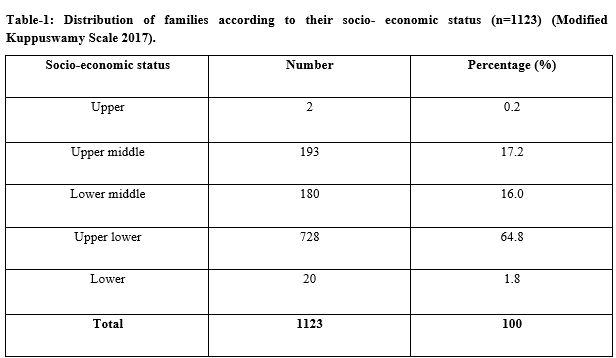A study to evaluate the functioning of primary health care workers at the village level in rural Amritsar, Punjab, India
Abstract
Background: About 68% of the total population lives in rural India; which makes it important to focus on rural areas. The only way to avoid poverty in these areas; induced by healthcare expenditures, is to strengthen the public healthcare system. Here the role of primary health care workers becomes imperative in order to facilitate the community participation and to address various social and cultural barriers in the etiology of health and disease.
Methods: The present cross-sectional study was carried out in village Nagkalan, Amritsar, where the eldest adult member present in the house at the time of the visit was interviewed. Every house of the village was visited during the period of January 2017 to December 2017, and a total of 1123 families were included in the final analysis. Thereafter, data was compiled and analyzed.
Results: Majority of the families (72.7%), were visited by the ASHA occasionally; whereas 13.7% were never visited by her. Out of 969 families visited by ASHA worker, 73.4% were visited for imparting knowledge regarding immunization services while 29.9% and 14.1% were visited for maternal and child health services and treatment of minor ailments respectively. The association between socio-economic status and home visits performed by ASHA was found to be statistically significant. The study also revealed that only 8.3% and 1% of the families were ever visited by the female and male multipurpose health workers respectively. Out of total 1123 families, 99.1% were aware about the existence of Anganwadi centres in their village. However, out of those who knew, 69.4% ever visited the centre. Out of those who ever visited the Anganwadi centre, 68.8%, reported that the food availability there was occasional and mostly irregular.
Conclusion: The present study concluded that the home visits were mostly carried out by the ASHA workers (that too on occasional basis) while the contribution made by the multipurpose health workers was very less. The main reasons cited for the visits by ASHA worker were immunization of children, MCH related activities and for the treatment of minor ailments. Most of the families were aware about the existence of Anganwadi centre in the village; however majority of them reported that the food availability at the centre was occasional and mostly irregular.
Downloads
References
Saprii L, Richards E, Kokho P, Theobald S. Community health workers in rural India: analysing the opportunities and challenges Accredited Social Health Activists (ASHAs) face in realising their multiple roles. Hum Resour Health. 2015;13:95. doi: 10.1186/s12960-015-0094-3.
Jain N, Srivastava NK, Khan AM, Dhar N, Manon S, Adhish V, Nandan D. Assessment of functioning of ASHA under NRHM in Uttar Pradesh. Health and Population: Perspectives and Issues. 2008;31(2):132-140.
Sarin J, Jeeva S, Geetanjli PS. Practices of Auxiliary Nurse Midwives regarding care of baby at birth. Nurs Midwif Res. 2011;7(3):110-119.
Singh S, Upadhyaya S, Deshmukh P, Dongre A, Dwivedi N, Dey D, et al. Time motion study using mixed methods to assess service delivery by frontline health workers from South India: methods. Hum Resour Health. 2018;16(1):17. doi: 10.1186/s12960-018-0279-7.
Dayal MS. Integrated child development services. Health and Population: Perspectives and Issues. 1979;2(1):80-83.
Garg PK, Bhardwaj A, Singh A, Ahluwalia SK. An evaluation of ASHA worker’s awareness and practice of their responsibilities in rural Haryana. National J Community Med. 2013;4(1):76-80.
Bajpai N, Dholakia RH. Improving the performance of accredited social health activists in India. Mumbai: Columbia Global Centres South Asia. 2011 May.
Singh MK, Singh J, Ahmad N, Kumari R, Khanna A. Factors Influencing Utilization of ASHA Services under NRHM in Relation to Maternal Health in Rural Lucknow. Indian J Community Med. 2010;35(3):414-419. doi: 10.4103/0970-0218.69272.
NFHS-4, State Fact Sheet Punjab. 2015. [cited 2019 Nov 02] Available from: http://rchiips. org/nfhs/pdf/NFHS4/PB_FactSheet.pdf
National Family health survey 2015-16, Punjab. [cited 2019 Nov 02] Available from: http://rchiips.org/NFHS/NFHS-4Reports/Punjab.pdf
Kaur B, Deepti SS, Mahajan S. Knowledge, Attitude and Practices Assessment of Rural Population towards Public Health Facilities in Amritsar District. Int J Health Sci Res (IJHSR). 2015;5(2):32-36
Mittra P, Nair KS, Gandotra R. A Study of Client Satisfaction with Services Provided by Sub-Centres in Two Districts of Andhra Pradesh. Health and Population: Perspectives and Issues. 2000;23(2):85-94.
Shah AG, Davda B, Parikh S, Bala DV. Time-motion study of the multipurpose health worker in the primary health center and subcenters in Kanbha, Ahmedabad district, Gujarat. Int J Med Sci Pub Health. 2016;5(1):142-146. doi: 10.5455/ijmsph.2016.2206201533.
Sandhyarani MC, Rao CU. Role and responsibilities of anganwadi workers, with special reference to Mysore district. Int J Sci Environ Tech. 2013;2(6):1277-1296.
Sahoo J, Mahajan PB, Paul S, Bhatia V, Patra AK, Hembram DK. Operational Assessment of ICDS Scheme at Grass Root Level in a Rural Area of Eastern India: Time to Introspect. J Clin Diagn Res. 2016;10(12):LC28-LC32. doi: 10.7860/JCDR/2016/23059.9041. Epub 2016 Dec 1.
An Assessment of the Integrated Child Development Services Programme in an Urban Area of Ludhiana, Punjab. Research Gate. [updated 2015 Mar; cited 2019 Nov 02] Available from: https://www.researchgate.net/publication/281022186_An_Assessment_of_the_Integrated_Child_Development_Services_Programme_in_an_Urban_Area_of_Ludhiana_Punjab

Copyright (c) 2019 Author (s). Published by Siddharth Health Research and Social Welfare Society

This work is licensed under a Creative Commons Attribution 4.0 International License.


 OAI - Open Archives Initiative
OAI - Open Archives Initiative


